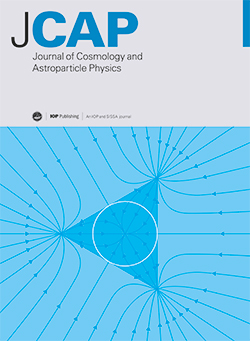单模引力下双星系统的引力辐射
IF 5.3
2区 物理与天体物理
Q1 ASTRONOMY & ASTROPHYSICS
Journal of Cosmology and Astroparticle Physics
Pub Date : 2025-02-12
DOI:10.1088/1475-7516/2025/02/027
引用次数: 0
摘要
单模态引力(UG)在经典上被认为与广义相对论(GR)相同。然而,由于受限衍射对称性,比安奇等值线并不导致能动张量守恒。因此,需要单独假设能量-动量张量守恒,才能与 GR 相一致。放宽这一假设,我们会发现违反守恒会导致与 GR 的差异,这可以随后在天体物理学和宇宙学场景中进行检验。为此,我们以发射引力辐射的双星系统为背景,研究了 UG 的预测。首先,我们展示了场方程如何涉及扩散函数,该函数量化了非守恒的程度。由于这种违反,弥散关系被修改了。结合这些变化,我们提供了双星能量损耗的表达式,并将其还原为 GR 限度下的彼得斯-马修斯(Peters-Mathews)结果。利用双脉冲星数据,我们通过确定轨道衰变率来约束理论参数ζ(表示非守恒)。对ζ的最强约束是|ζ|≤ 5× 10-4,比现有的来自中子星潮汐变形的等效约束好一个数量级。本文章由计算机程序翻译,如有差异,请以英文原文为准。
Gravitational radiation from binary systems in unimodular gravity
Unimodular gravity (UG) is classically considered identical to General Relativity (GR). However, due to restricted diffeomorphism symmetry, the Bianchi identites do not lead to the conservation of energy-momentum tensor. Thus, the conservation of energy-momentum tensor needs to be separately assumed in order to reconcile with GR. Relaxing this assumption, one finds that the conservation violation can lead to differences with GR, which can be subsequently examined in astrophysical and cosmological scenarios. To this end, we examine the predictions of UG in the context of binary systems emitting gravitational radiation. Primarily, we show how the field equations involve a diffusion function which quantifies the measure of non-conservation. Due to this violation, the dispersion relation is modified. Incorporating these changes, we provide an expression for the energy loss by the binaries, which reduces to Peters-Mathews result in the GR limit. Using binary pulsar data, we constrain the theory parameter ζ (which signifies non-conservation) by determining the rate of orbital decay. The strongest constrain on ζ comes out to be |ζ|≤ 5× 10-4 which is better by an order of magnitude than an existing equivalent constraint coming from the tidal deformability of the neutron stars.
求助全文
通过发布文献求助,成功后即可免费获取论文全文。
去求助
来源期刊

Journal of Cosmology and Astroparticle Physics
地学天文-天文与天体物理
CiteScore
10.20
自引率
23.40%
发文量
632
审稿时长
1 months
期刊介绍:
Journal of Cosmology and Astroparticle Physics (JCAP) encompasses theoretical, observational and experimental areas as well as computation and simulation. The journal covers the latest developments in the theory of all fundamental interactions and their cosmological implications (e.g. M-theory and cosmology, brane cosmology). JCAP''s coverage also includes topics such as formation, dynamics and clustering of galaxies, pre-galactic star formation, x-ray astronomy, radio astronomy, gravitational lensing, active galactic nuclei, intergalactic and interstellar matter.
 求助内容:
求助内容: 应助结果提醒方式:
应助结果提醒方式:


